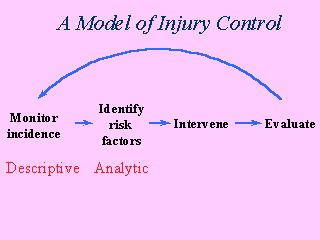|
|
|
|
front |1 |2 |3 |4 |5 |6 |7 |8 |9 |10 |11 |12 |13 |14 |15 |16 |17 |18 |19 |20 |21 |22 |23 |24 |review |
 |
The basis for the lecture is the distinction between descriptive
epidemiology and analytic epidemiology in the field of injuries.
Descriptive epidemiology seeks to measure the frequency in which
injuries occur or collect descriptive data on possible causal
factors. Analytic epidemiology attempts to specify in more
detail the causes of injury (Robertson, 1992).
Studies in both areas are necessary for the development of appropriate injury control programs. The public health model outlined here illustrates how the two disciplines work together for controlling injuries. Injury control comes about from a good understanding of both the frequency in which the events occur (through surveillance), but also the risk factors that lie behind their occurrence (through analytic epidemiologic studies). One caution, however, is that the success of several previous injury control measures have led many individuals to espouse control measures in areas where we do not have appropriate measures for incidence nor the causal factors behind the injury occurrence. |
|
|
|
|
front |1 |2 |3 |4 |5 |6 |7 |8 |9 |10 |11 |12 |13 |14 |15 |16 |17 |18 |19 |20 |21 |22 |23 |24 |review |